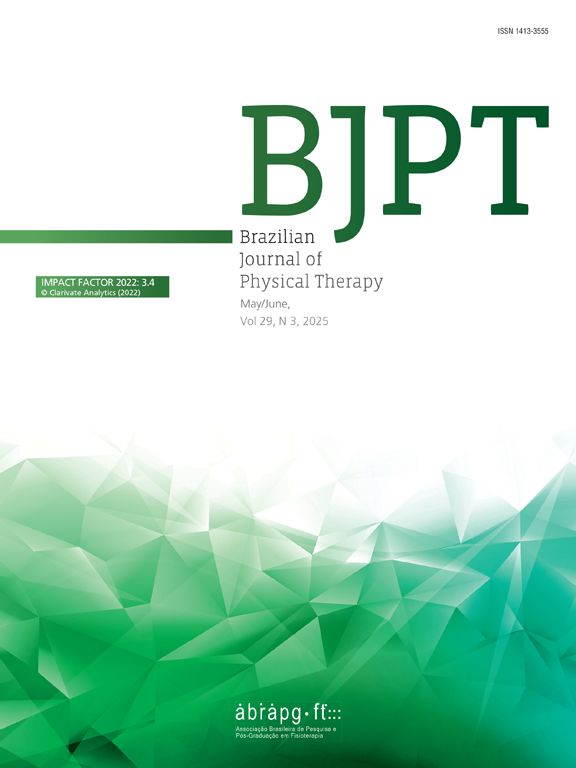13
What are the unsupervised exercise adherence rates in clinical trials for knee osteoarthritis? A systematic reviewKristin M. Smith, B. James Massey, Jodi L. Young, Daniel I. Rhon
Braz J Phys Ther. 2023;27:100533
13
Highlights
- •
Exercise trials for knee osteoarthritis are not consistently collecting and reporting information about exercise adherence.
- •
Without information about adherence, the understanding of true treatment effect sizes of exercise for individuals with knee osteoarthritis is limited.
- •
Only 10.2% of trials provided a predetermined threshold of adequate adherence, and outcomes did not appear to differ in those who met the threshold. However, metrics, thresholds, and comparator groups were highly heterogeneous in these trials, limiting any conclusions.
12
Affordance-based practice: An ecological-enactive approach to chronic musculoskeletal pain managementDaniela Virgínia Vaz, Peter Stilwell, Sabrina Coninx, Matthew Low, Craig Liebenson
Braz J Phys Ther. 2023;27:100554
12
Highlights
- •
The ecological-enactive approach to pain extends the biopsychosocial model.
- •
Clinical reasoning and practice centers around affordances: opportunities for action.
- •
Disabling pain is experienced as closed-off or “stuck” field of affordances.
- •
Therapist and patient work together to make sense of pain, complexity, and uncertainty.
- •
Together, they choose interventions aimed to “open-up” the field of affordances.
12
Effectiveness of intensive versus regular or no exercise in older adults after hip fracture surgery: A systematic review and meta-analysisFan Bai, Minmin Leng, Yan Zhang, Jinli Guo, Zhiwen Wang
Braz J Phys Ther. 2023;27:100482
12
Highlights
- •
Intensive exercise in the early postoperative rehabilitation after hip fracture (up to 3 months postoperatively) is beneficial to the recovery of physical function in older adults.
- •
Intensive exercise with more load lead to greater improvements in muscle strength, balance, and functional ability.
- •
Older adults with cognitive impairment were not included in the studies selected for this review, conclusions about the training results may not be extended to this population.
12
Person-centred education and advice for people with low back pain: Making the best of what we knowEdel T. O'Hagan, Aidan G. Cashin, Adrian C. Traeger, James H. McAuley
Braz J Phys Ther. 2023;27:100478
12
Highlights
- •
There is little guidance for physical therapists on how best to provide first line care for people with low back pain.
- •
Providing validation to patients seems important.
- •
The AxEL-Q is a valid and reliable tool that could help to guide physical therapy consultations.
- •
Physical therapists could consider focusing patient education and advice on messages about cause, severity, and imaging, and in doing so remove barriers to physical activity.
11
Consensus-based recommendations on physical activity and exercise in patients with diabetes at risk of foot ulcerations: a Delphi studyAlba Gracia-Sánchez, Adriana López-Pineda, José Luis Lázaro-Martínez, Antonio Pérez, Francisco J. Pomares-Gómez, Lourdes María Fernández-Seguín, Vicente F. Gil-Guillén, Esther Chicharro-Luna
Braz J Phys Ther. 2023;27:100500
11
Highlights
- •
We propose a series of structured recommendations, based on the consensus of international, multidisciplinary experts, on factors to consider before, during, and after physical activity/exercise, thus facilitating the advisory role of health professionals.
- •
These recommendations include the systematic analysis of the degree of risk presented by patients with diabetic foot before starting unsupervised physical activity.
- •
Patients at high risk of ulceration should be closely monitored, including during their return to activity after ulceration, and it is recommended that those with open ulcers or peripheral artery disease perform stretching and strengthening exercises.
11
Breaking barriers to rehabilitation: the role of behavior change theories in overcoming the challenge of exercise-related behavior changeManuela Karloh, Thiago Sousa Matias, Joice Mara de Oliveira, Fabiano Francisco de Lima, David Halen Araújo Pinheiro, Graziele Besen Barbosa, Karina Couto Furlanetto, Celso R.F. Carvalho
Braz J Phys Ther. 2023;27:100574
11
Highlights
- •
Rehabilitation programs fail to promote exercise-related behavior change.
- •
The one-size-fits-all approach to promoting behavior change is impractical.
- •
Multiple theories and strategies are needed for successful behavior change.
- •
We explained the key points of six theories for behavior change.
- •
Rehabilitation staff must intentionally implement strategies to change behavior.





